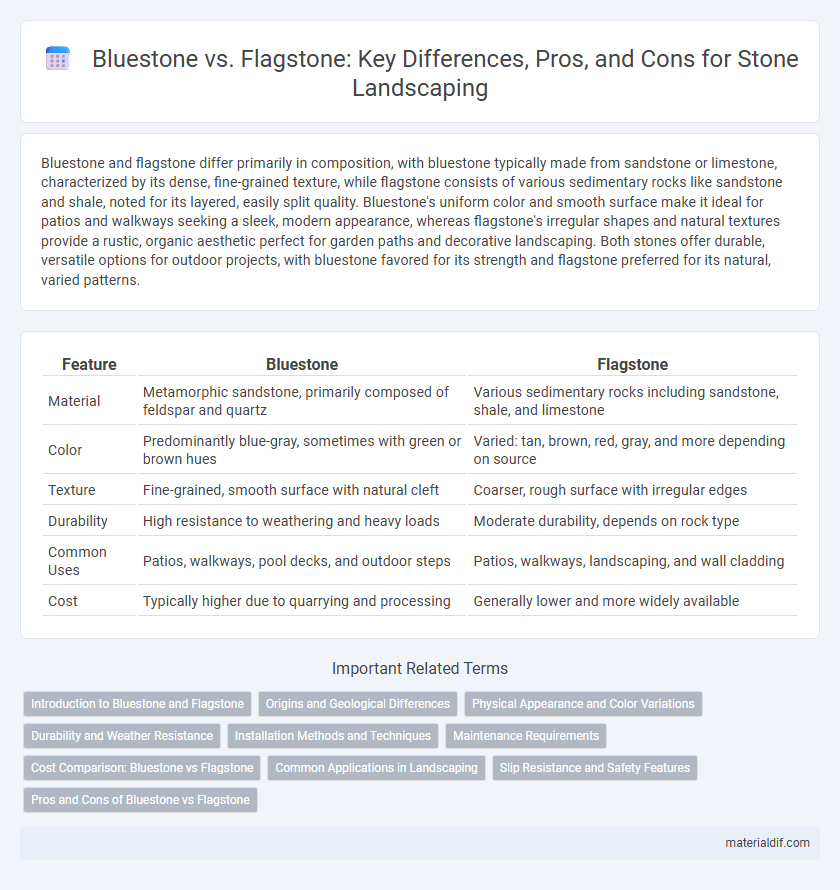Bluestone and flagstone differ primarily in composition, with bluestone typically made from sandstone or limestone, characterized by its dense, fine-grained texture, while flagstone consists of various sedimentary rocks like sandstone and shale, noted for its layered, easily split quality. Bluestone's uniform color and smooth surface make it ideal for patios and walkways seeking a sleek, modern appearance, whereas flagstone's irregular shapes and natural textures provide a rustic, organic aesthetic perfect for garden paths and decorative landscaping. Both stones offer durable, versatile options for outdoor projects, with bluestone favored for its strength and flagstone preferred for its natural, varied patterns.
Table of Comparison
| Feature | Bluestone | Flagstone |
|---|---|---|
| Material | Metamorphic sandstone, primarily composed of feldspar and quartz | Various sedimentary rocks including sandstone, shale, and limestone |
| Color | Predominantly blue-gray, sometimes with green or brown hues | Varied: tan, brown, red, gray, and more depending on source |
| Texture | Fine-grained, smooth surface with natural cleft | Coarser, rough surface with irregular edges |
| Durability | High resistance to weathering and heavy loads | Moderate durability, depends on rock type |
| Common Uses | Patios, walkways, pool decks, and outdoor steps | Patios, walkways, landscaping, and wall cladding |
| Cost | Typically higher due to quarrying and processing | Generally lower and more widely available |
Introduction to Bluestone and Flagstone
Bluestone is a dense, fine-grained sandstone known for its blue-gray color and durability, commonly used in patios, walkways, and pool coping. Flagstone is a sedimentary rock that comes in various types such as sandstone, limestone, or slate, characterized by its flat, layered structure ideal for outdoor flooring and garden paths. Both stones offer unique textures and natural beauty, making them popular choices for landscaping and architectural projects.
Origins and Geological Differences
Bluestone originates primarily from basalt or sandstone formations found in regions like the Northeastern United States, characterized by its dense, fine-grained texture and rich blue-gray hues. Flagstone, derived mainly from sedimentary rocks such as sandstone, limestone, or shale, forms in layers that naturally split into flat slabs, showcasing a broader color palette from tan to reddish-brown. The geological distinction lies in bluestone's igneous or metamorphic origins creating a harder, more compact surface, whereas flagstone's sedimentary layering results in a softer, more porous and versatile stone.
Physical Appearance and Color Variations
Bluestone typically has a uniform, fine texture with colors ranging from medium to dark bluish-gray, often showing subtle hints of blue or green. Flagstone exhibits a more varied texture and color palette, including tans, browns, reds, and grays, creating a natural, rustic appearance with irregular shapes. The distinct layering in flagstone results in a rougher surface compared to the smoother, more consistent finish of bluestone.
Durability and Weather Resistance
Bluestone and flagstone both exhibit strong durability, but bluestone is generally more dense and resistant to chipping, making it suitable for high-traffic areas. Flagstone offers better weather resistance due to its natural ability to withstand freeze-thaw cycles and resist moisture penetration, which helps prevent cracking and surface erosion. Choosing between bluestone and flagstone depends on the specific environmental conditions and intended use in outdoor landscaping projects.
Installation Methods and Techniques
Bluestone installation typically involves setting the stone on a sand or mortar base to ensure stability and prevent shifting, often requiring precise leveling for an even surface. Flagstone is commonly installed using a dry-laid method with a compacted gravel base, allowing for natural drainage and flexibility, or with mortar for a more permanent, uniform finish. Both stones demand careful joint filling with sand or mortar to maintain structural integrity and prevent weed growth.
Maintenance Requirements
Bluestone requires regular sealing to prevent staining and moisture damage, with maintenance usually involving cleaning with mild soap and water to preserve its natural finish. Flagstone demands less frequent sealing, as its denser composition offers greater resistance to wear and weather, but still benefits from occasional cleaning to remove debris and prevent moss growth. Both stones need prompt attention to spills and cracks to extend their longevity and maintain aesthetic appeal in outdoor settings.
Cost Comparison: Bluestone vs Flagstone
Bluestone typically costs between $8 to $18 per square foot, while flagstone ranges from $5 to $15 per square foot, making flagstone generally more affordable. Installation costs for both stones vary, but bluestone's durability can reduce long-term maintenance expenses. When budgeting for paving or landscaping, factoring in both material and labor costs is essential for accurate comparison.
Common Applications in Landscaping
Bluestone is frequently used for patios, walkways, and pool surrounds due to its durability and slip-resistant surface, making it ideal for high-traffic outdoor areas. Flagstone is favored for garden paths, stepping stones, and naturalistic landscaping because of its irregular shapes and diverse color variations that blend seamlessly with natural environments. Both stones are popular in hardscape design but serve different aesthetic and functional purposes based on their texture and installation flexibility.
Slip Resistance and Safety Features
Bluestone offers superior slip resistance compared to flagstone due to its natural cleft surface texture, which provides enhanced grip even when wet, making it ideal for outdoor walkways and pool surrounds. Flagstone, typically smoother and more polished, may require additional treatment or sealing to improve slip resistance and ensure safety in high-traffic or moisture-prone areas. Choosing bluestone enhances safety features by reducing the risk of slips and falls, especially in commercial or residential landscapes where pedestrian safety is paramount.
Pros and Cons of Bluestone vs Flagstone
Bluestone offers dense durability and a smooth surface, making it ideal for patios and walkways that require slip resistance; however, it tends to be more expensive and heavier than flagstone. Flagstone is prized for its natural, irregular shapes and warm earth tones, providing aesthetic versatility and easier installation, but it is generally softer and more prone to chipping and cracking under heavy traffic. Choosing between bluestone and flagstone depends on budget constraints, desired texture, and the specific environmental conditions of the installation site.
Bluestone vs Flagstone Infographic

 materialdif.com
materialdif.com